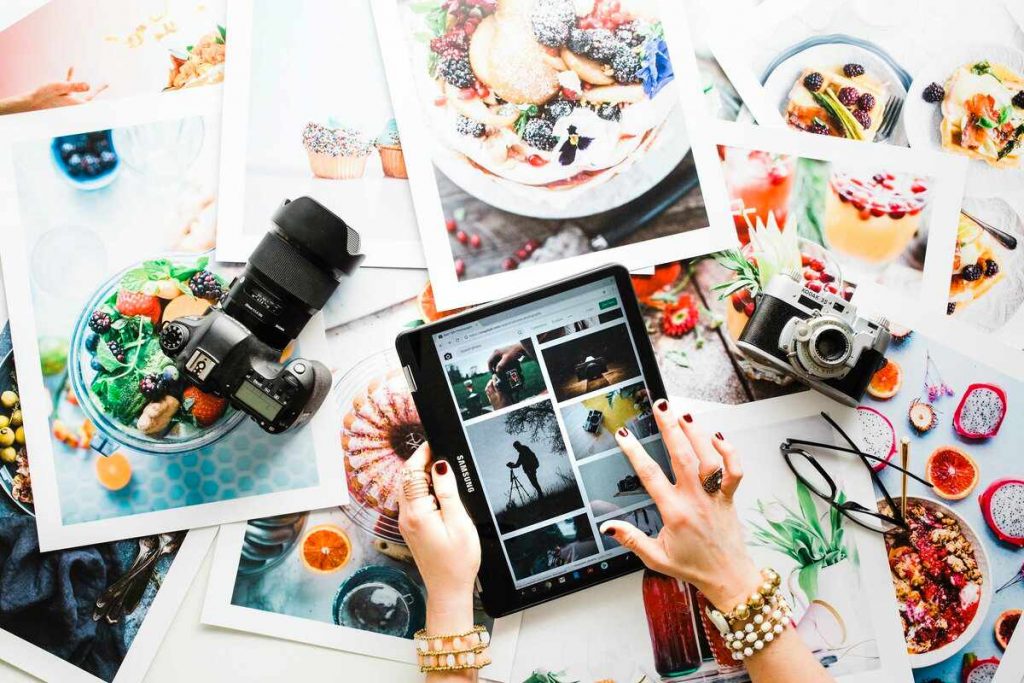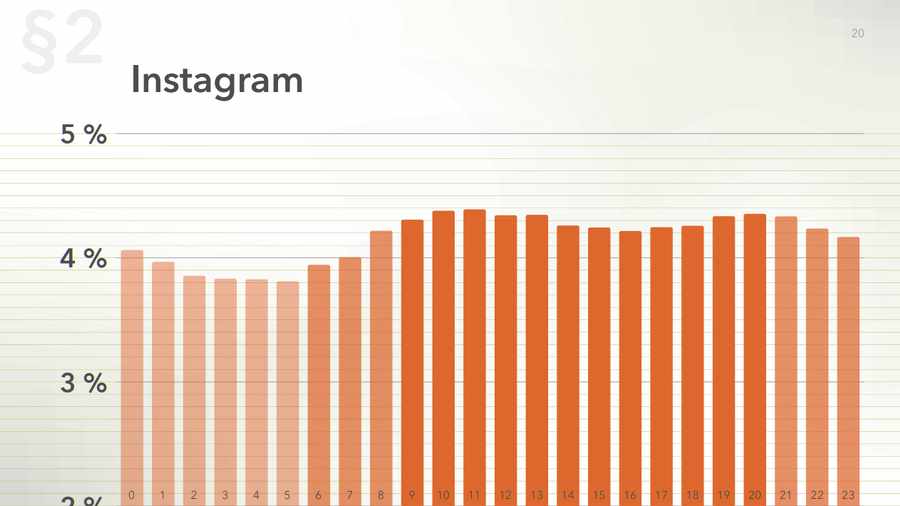
Let's face it: it's more accurate to phrase this question as, is there even a better time to post to Instagram?
With the advent of algorithmic feeds, the nature of feed formation has changed, and the timing of publishing content no still has a significant impact on reach. So, bloggers and businesses are trying to find a correlation between publishing time and engagement.
You've probably noticed that posts published at a certain time get a better response rate. Together with the quantity of Instagram likes (and its dynamics), Instagram's algorithms take into account the relevance of a post when generating a smart feed: how long ago it was published. Newer posts have a better chance of showing up higher in subscribers' feeds.
So the best time to post to Instagram is close to when your audience is online, to increase the novelty factor.
What is the best time to post to Instagram?
There are many myths about the right time to post. The recommendations are similar: the best are called the morning (10 a.m.) and evening (6-20 p.m.) of weekdays. Sometimes they mention the ineffectiveness of posting on weekends – which may have been true before the development of mobile internet. Now users stay online at any time.
Let's try to identify a general recommendation for when it's best to post photos on Instagram, as well as the specifics of choosing the right time to post based on the research.
Hootsuit research
There was a study in 2018, based on data from 460 million posts on 7 social networks, created by 580,000 different public pages and groups.

The time and date analysis assessed the average activity in a post based on when it was published.
Day of the week for posting on Instagram
Publications made on Sunday had the highest engagement. The next most active day was Monday. Users were least active on posts made on Saturday.
On the other days of the week, activity remained the same.
Timing
The study confirmed the theory of increased activity in the morning and at the end of the day. Users were most active at 10-11 a.m. and 7-20 p.m. A slight increase in activity was also observed at 12 noon. This is worth considering when choosing the best time to post to Instagram.
Postings made at night (from midnight to 6 a.m.) gain fewer reactions. The worst time to post is 5 a.m.

The Hootsuit team also worked with Unmetric on an Instagram engagement study, which analyzed 258,956 posts from 20 of North America's most popular accounts across 11 industries. The results are not as relevant to companies operating in Russia as the study of local accounts, but are also useful to study, as they can generally give insight into when it's best to post photos to Instagram in other regions.
The study shows what times are better for posting to accounts in different areas.
- Travel and tourism: Friday, 9 a.m. to 1 p.m. Also, good days are Tuesday and Monday.
- Media and entertainment: Tuesday and Thursday, 12 to 3 p.m.
- Food and drink: Friday, 12 noon.
- Retail: Tuesday, Thursday, Friday, 12 noon.
- Services and facilities: Friday, Tuesday, Wednesday, 9 a.m. or 10 a.m.
- Nonprofits: Tuesday, 4 p.m. or 10 a.m.
- E-commerce (except retail): Thursday, 9 p.m. or 4 a.m.
- Medicine and pharmacy: Wednesday and Saturday, 9 a.m.
- Cosmetics: Friday and Thursday, 1, 2 or 3 p.m.
- Technology: Monday and Tuesday, 2 p.m.
- Education: Thursday, 4pm or 5pm.
Worst time to post: 11 a.m. to 1 p.m.
What seems to be the best time to publish Instagram posts?
The data from the study give a general idea of the impact of publication times on activity. They are relevant for many pages, but the situation may be different for some accounts. To determine the best time to post to Instagram specifically for your account, analyze the results for older posts.
Analyzing Instagram stats
Use the built-in analytics of your Instagram account. It is available for business accounts: if your account type is "personal", you will not see this data. You can connect a business account in the settings. You'll need to link your Facebook business page to your Instagram profile. If you don't have one, the social network will prompt you to create one right when you switch accounts. It does not need to be filled out and updated later, the page exists nominally, only to include the business profile.
The important difference between a business profile: it cannot be made private. Therefore, if you need privacy, this method of finding the best time to publish posts will not work for you.
Statistics will begin to be collected only after you enable the business profile. If you're doing it now, while reading the article, wait for the data to accumulate. To estimate the days of the week and time of day posts are published, you'll need to collect data for 3-4 weeks.
Go to Statistics and analyze which days of the week and times of day your subscribers are most active. If you click on the graph, you'll see absolute values – the number of users among your followers who are online in Instagram at the specified time.
You'll also see data about the geography of your followers – consider the time zones when calculating the best time to post to Instagram.
Experiments
Try posting photos to Instagram at different times and analyze the feedback. Of course, the result will not be entirely objective, because other factors (and first of all, the content) influence the engagement of the publication. But with a lot of data, you'll see general trends that will help you determine the best time to post to Instagram.
A simple spreadsheet will work for collecting results – record the date and time the post was published, as well as the number of reactions received (likes, comments, reposts, saves). For accuracy, take data at the same time – for example, exactly one day after the post was published.
The worst time to post on Instagram
If there is a best time to post on Instagram, there must also be a worst time. If you know the age and time zone of your followers, you can even use logic to find the worst time – high school students and adults will probably be offline at night, so they won't see your posts. Because of the low response rate, Instagram's algorithms will decide that your post is not interesting and won't show it in the subscribers' feed when they are online.
Statistics from different accounts prove this point. A study by Popsters found that the worst time to post was 5 a.m., and a Hubspot study determined the worst time to post was between 3 and 4 a.m.
Rules for determining publication times
Research your audience
Analyze your account data through Instagram's internal analytics tool or third-party services. Update regularly: audience behavior can change. Follow studies on the topic: they will provide more information than you can gather on your own because they use statistics from hundreds of thousands of publications.
Experiment
Keep improving your performance and testing new hypotheses. Don't stop at just the "best time" to publish so you don't lose your audience active at other times-even if it's a small fraction of your subscribers.
Work with the content
While publishing time plays a role in ranking a post in subscribers' feeds, the quality of the photo and text remains a major factor in the success of the post and the entire account.
When to post Instagram stories
According to Buffer, a marketing portal, more than 550 million users post and view storis every day. The greatest bursts of activity are seen during off-hours: in the morning before work, at lunchtime, and in the evening, which is when it's best to post stories on Instagram.
In addition to posting times, it's important to consider the appropriate number of storis – Buffer research suggests that the optimal amount is up to 7 pieces per day. The same limits are usually mentioned by smm managers and experienced bloggers – they advise posting about 5-7 stories daily. Another thing is if you use the technique of storytelling – then you will need more storis to tell your story.
It's important that the first story you publish is compelling and engaging. If it's uninteresting, your followers are likely to simply flip through the rest, Buffer's data confirms. According to the portal's research, there's a drop in views right after the first storis, and the second and subsequent stories are watched by about 80% of the audience.
To increase views of storis, try to publish engaging content, and do it outside of business hours – when your audience is more active and ready to respond to your photos and videos.
When it's best to post reels
Reels is a new Instagram feature that helps you organically increase your reach and gain new followers. It only appeared in 2021 and is not yet available to all accounts, so it's too early to talk about any research on the best time to post, but we already know that activity is important for rils. Many bloggers advise posting 2-3 videos of 8-10 seconds daily.
If a video doesn't "get in" right away, don't get upset and don't rush to delete it – it often happens that videos start gaining views a few days after publication.
Other factors to consider
Different audiences will be active at different times, of course, so there's no hard-and-fast rule about the best time to post to Instagram. But there are some general rules you should consider:
#1: Instagram's algorithm affects timeliness
As we mentioned a little earlier, Instagram's algorithm places a high value on the timing of publishing something.
Does that mean chronological backlinking is back? – Not really. Instagram has adjusted its current algorithm so that, among other things, very old content doesn't consistently end up in people's feeds. It basically prioritizes newer content.
There are a number of factors that affect the Instagram Algorithm, including how engaged a post is and how much time people spend viewing a post.
With recent changes, Instagram has significantly changed the importance (or weight) of these factors, so that the time people post has a greater impact on what appears in your feed.
#2: Scheduling your posts can increase your engagement
We've already covered this issue to some extent – if you publish a post when your audience is most active on Instagram, you have a better chance of getting attention for that post. But did you know that engagement on Instagram has a tricky effect?
When a post gets a lot of likes, comments, and saves, that interaction will cause Instagram to elevate your post higher in users' feeds and possibly get a spot on the Instagram Explore page, which in turn can lead to even more engagement with your post.
It's a cyclical process: the more engagement, the more visibility, which leads to more engagement, which leads to more visibility. But it all starts when you post on Instagram.
#3: Publish in more active time zones
If your primary audience lives in a certain region, such as California, you should publish posts with the Pacific Standard Time (PST) time zone in mind. Similarly, if most of your subscribers are in New York City, you should publish posts in Eastern Standard Time (EST).
But what if your subscribers are scattered all over the world? That's where experimentation comes in handy!
Also, keep in mind that if you have subscribers in both North America and the UK, you may find that posting at the "odd" time in your time zone (like midnight Pacific Time) suits you because it's 8 a.m. in London, England.
Want a quick guide to when it's best to post around the world? It later teamed up with opinion leader marketing platform Fohr to analyze influencer publishing habits and trends for the future.
After analyzing thousands of influencers and their posts, they discovered these key times to publish around the world:
Of course, you'll still need to find your own personal posting time, but you can use their results as a starting point!
#4: Finding the best time to post also applies to IGTV and Instagram Reels
IGTV and Instagram Reels are also influenced by Instagram's algorithm, so it's also a good idea to post these videos at a convenient time!
Since Instagram Stories live for 24 hours, it's not as important to post your stories at the "optimal" time – although it can't hurt!
#5: Post more after hours, not during the day
As a general rule, it's best to post on Instagram during lunchtime (11 a.m. to 1 p.m.) and evening (7-9 p.m.).
Instead of posting posts while at your desk, schedule your Instagram posts during the work day so you don't have to worry about it during your free time!
#6: Save your important posts for weekdays
The differences are small, but average Instagram engagement varies from day to day.
For example, B2B companies may get more engagement during the week when their audience is at work, while bloggers may get more feedback on weekends when their audience is more likely to have time to read posts.

Written by Michael Zippo
Michael Zippo, passionate Webmaster and Publisher, stands out for his versatility in online dissemination. Through his blog, he explores topics ranging from celebrity net worth to business dynamics, the economy, and developments in IT and programming. His professional presence on LinkedIn - https://www.linkedin.com/in/michael-zippo-9136441b1/ - is a reflection of his dedication to the industry, while managing platforms such as EmergeSocial.NET and theworldtimes.org highlights his expertise in creating informative and timely content. Involved in significant projects such as python.engineering, Michael offers a unique experience in the digital world, inviting the public to explore the many facets online with him.
